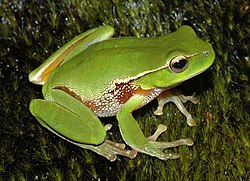| Bufonidae - 1 genus, 1 species (introduced) |
| Genus | Common names | Example species | Example photo | Australian range |
|---|
Rhinella - 1 species
Fitzinger, 1826 | Beaked toads or Rio Viejo toads | Cane toad (Rhinella marinus) |  | 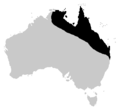 Map now out of date. |
| Hylidae - 1 sub-family, 3 genera, 78 species |
| Genus | Common names | Example species | Example photo | Australian range |
|---|
Cyclorana - 13 species
Steindachner, 1867 | Water holding frogs | Striped burrowing frog (Cyclorana alboguttata) |  | 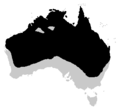 |
Litoria - 64 species
Tschudi, 1838 | Tree frogs | White's tree frog (Litoria caerulea) |  |  |
Nyctimystes - 1 species
Stejneger, 1916 | Big eyed tree frogs | Australian lace-lid (Nyctimystes dayi ) |  |  |
| Microhylidae - 1 sub-family, 2 genera, 19 species |
| Genus | Common names | Example species | Example photo | Australian range |
|---|
Austrochaperina - 5 species
Fry, 1912 | Nursery frogs | Fry's frog (Austrochaperina fryi) |  | 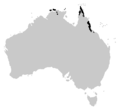 |
Cophixalus - 14 species
Boettger, 1892 | Rainforest frogs | Ornate nurseryfrog (Cophixalus ornatus) |  |  |
| Myobatrachidae - 3 sub-families, 20 genera, 119 species (3 extinct) |
| Genus | Common names | Example species | Example photo | Australian range |
|---|
Adelotus - 1 species
Ogilby, 1907 | Tusked frog | Tusked frog (Adelotus brevis) |  |  |
Arenophryne - 2 species
Tyler, 1976 | Sandhill frog | Sandhill frog (Arenophryne rotunda) |  | 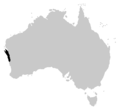 |
Assa - 1 species
Tyler, 1972 | Pouched frog | Pouched frog (Assa darlingtoni) |  |  |
Crinia - 15 species
Tschudi, 1838 | Australian froglets | Common eastern froglet (Crinia signifera) | 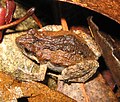 | 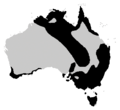 |
Geocrinia - 7 species
Blake, 1973 | Ground froglets | Smooth frog (Geocrinia laevis) |  |  |
Heleioporus - 6 species
Gray, 1841 | Giant burrowing frogs | Giant burrowing frog (Heleioporus australiacus) |  |  |
Lechriodus - 1 species
Boulenger, 1882 | Cannibal frogs | Fletcher's frog (Lechriodus fletcheri) |  | 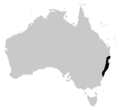 |
Limnodynastes - 13 species
Fitzinger, 1843 | Australian swamp frogs | Eastern banjo frog (Limnodynastes dumerilli) |  | 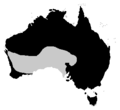 |
Metacrinia - 1 species
Parker, 1940 | Nicholl's toadlet | Nicholl's toadlet (Metacrinia nichollsi) | - |  |
Mixophyes - 5 species
Günther, 1864 | Barred frogs | Great barred frog (Mixophyes fasciolatus) |  |  |
Myobatrachus - 1 species
Tyler, 1976 | Turtle frog | Turtle frog (Myobatrachus gouldii) |  |  |
Neobatrachus - 10 species
Peters, 1863 | Stubby frogs | Painted frog (Neobatrachus pictus) | 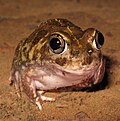 | 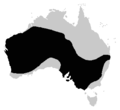 |
Notaden - 4 species
Günther, 1873 | Australian spadefoot toads | Crucifix toad (Notaden bennettii) |  |  |
Opisthodon - 2 species
Steindachner, 1867 | - | Ornate burrowing frog (Opisthodon ornatus) |  | 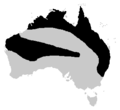 |
Paracrinia - 1 species
Heyer and Liem, 1976 | Haswell's froglet | Haswell's froglet (Paracrinia haswelii) |  |  |
Philoria - 6 species
Spencer, 1901 | Mountain frogs | Sphagnum frog (Philoria sphagnicolus) |  |  |
Pseudophryne - 13 species
Fitzinger, 1843 | Toadlets or brood frogs | Red-crowned toadlet (Pseudophryne australis) |  |  |
Rheobatrachus - 2 species
Liem, 1973 | Gastric brooding frogs | Southern gastric brooding frog (Rheobatrachus silus) |  |  |
Spicospina - 1 species
Roberts, Horwitz, Wardell-Johnson, Maxson, and Mahony, 1997 | Sunset frog | Sunset frog (Spicospina flammocaerulea) | - |  |
Taudactylus - 6 species
Straughan and Lee, 1966 | Torrent frogs | Eungella torrent frog (Taudactylus eungellensis) |  |  |
Uperoleia - 24 species
Gray, 1841 | Australian toadlets | Tyler's toadlet (Uperoleia tyleri) |  |  |
| Ranidae - 1 genus, 1 species |
| Genus | Common names | Example species | Example photo | Australian range |
|---|
Papurana - 1 species
Linnaeus, 1758 | True frogs | Australian wood frog (Papurana daemeli) |  |  |
| Salamandridae - 1 genus, 1 species (introduced) |
| Genus | Common names | Example species | Example photo | Australian range |
|---|
Lissotriton - 1 species
Bell, 1839 | Common newts | Smooth newt (Lissotriton vulgaris) |  | |
|
